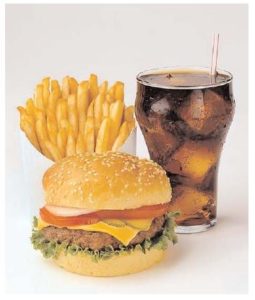
The results of a recent study may give extra motivation to those trying to cut back on the amount of fast food that they eat. The study found that consumption of fast food is linked to nonalcoholic fatty liver disease (NAFLD).
The researchers found moderate increases in liver fat in everyone consuming 20% or more of daily calories from fast food (about 1 meal a day). They also found that obese individuals or people with diabetes who consume 20% or more of their daily calories from fast food had severely elevated levels of fat in their liver.
We already know that fast foods are associated with a greater risk of diabetes and heart disease, and now NAFLD can be added. It is thought that NAFLD affects 30% of the U.S. population!
According to the US National Institute of Health: "Nonalcoholic fatty liver disease (NAFLD) is a condition in which fat builds up in your liver. Nonalcoholic fatty liver (NAFL) and nonalcoholic steatohepatitis (NASH) are types of NAFLD. If you have NASH, you have inflammation and liver damage, along with fat in your liver."
What to do about this abnormal build up of fat in the liver? The only treatment is changing your diet and losing weight. A healthy diet is one rich in fruits, vegetables, legumes, whole grains, seeds, and nuts. For example, a Mediterranean style diet.
From Science Daily: Consumption of fast food linked to liver disease
A study from Keck Medicine of USC published today in Clinical Gastroenterology and Hepatology gives people extra motivation to reduce fast-food consumption.
The study found that eating fast food is associated with nonalcoholic fatty liver disease, a potentially life-threatening condition in which fat builds up in the liver.
Researchers discovered that people with obesity or diabetes who consume 20% or more of their daily calories from fast food have severely elevated levels of fat in their liver compared to those who consume less or no fast food. And the general population has moderate increases of liver fat when one-fifth or more of their diet is fast food.
"Healthy livers contain a small amount of fat, usually less than 5%, and even a moderate increase in fat can lead to nonalcoholic fatty liver disease," said Ani Kardashian, MD, a hepatologist with Keck Medicine and lead author of the study. "The severe rise in liver fat in those with obesity or diabetes is especially striking, and probably due to the fact that these conditions cause a greater susceptibility for fat to build up in the liver."
The findings also reveal that a relatively modest amount of fast food, which is high in carbohydrates and fat, can hurt the liver. "If people eat one meal a day at a fast-food restaurant, they may think they aren't doing harm," said Kardashian. "However, if that one meal equals at least one-fifth of their daily calories, they are putting their livers at risk."
Nonalcoholic fatty liver disease, also known as liver steatosis, can lead to cirrhosis, or scarring of the liver, which can cause liver cancer or failure. Liver steatosis affects over 30% of the U.S. population.
Kardashian and colleagues analyzed the most recent data from the nation's largest annual nutritional survey, the 2017-2018 National Health and Nutrition Examination Survey, to determine the impact of fast-food consumption on liver steatosis. The study characterized fast food as meals, including pizza, from either a drive-through restaurant or one without wait staff.
The researchers evaluated the fatty liver measurement of approximately 4,000 adults whose fatty liver measurements were included in the survey and compared these measurements to their fast-food consumption.
Of those surveyed, 52% consumed some fast food. Of these, 29% consumed one-fifth or more daily calories from fast food. Only this 29% of survey subjects experienced a rise in liver fat levels.
The association between liver steatosis and a 20% diet of fast food held steady for both the general population and those with obesity or diabetes even after data was adjusted for multiple other factors such as age, sex, race, ethnicity, alcohol use and physical activity.
... Currently, the only way to treat liver steatosis is through an improved diet.
